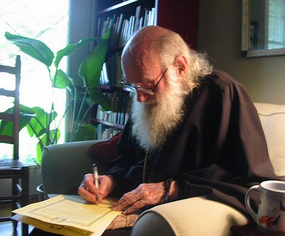Thinking about the way we come to understand the contours of our relationship to God we have the work of negative theology. We inhabit a world in which human beings have faith and reason and they pursue the beauty of Truth. The truth here is not an object but a person. Christians call truth by the name of Jesus of Nazareth, the Christ, the second Person of the Trinity. I like Father Dumitru Staniloae’s theological work since I encountered his writing a decade ago in theology school. Father is now deceased but he was an Orthodox priest and theologian of the Romanian Orthodox Church, who, in my opinion, has relevance for Catholics today.
Negative theology is still a mental operation, the final one, mixed, however, as prayer is, with a feeling of the powerlessness to comprehend God. It is related to the comprehension of God through nature, history, Holy Scripture, art, dogma and in general through everything which is between us and God either as an external reality or as a system of concepts and symbolic images. Every reality, concept or symbolic image mirrors God as well as awakens in us the proof or unexplainable feeling that God is totally different, in comparison with them; so they compel us to negate all the positive attributes which, because of them, we ascribe to God. In other words, all things in between open for us a perspective to God; at the same time they confront us with an infinite abyss of divine reality which we can’t grasp with our minds, and which first of all doesn’t show us anything that created realities, concepts and symbolic images do. But our mind, faced with this abyss still doesn’t give up looking at things, concepts and symbolic images, but turns its gaze from this to that and finds that they don’t give it the means to describe the abyss. It tries, we might say, to measure it with every measure in the world, in other words with every attribute or image, or with every concept based on created things. Finally, the mind realizes that not one is suitable. So it eliminates them one by one. Negative theology is therefore a mental operation because it investigates the context of various attributes and concepts and compares them with the divine abyss, which it lives somehow with feeling, and finds they are insufficient.
In a certain sense, negative theology is still a rational operation; it is still an exact weighing of each concept, whose limits only now appear to the mind in all their clarity. But the comprehension of the definite content of a concept is made at the same time as we cast our gaze over the divine abyss which reason can’t encompass, but which the mind gains by intuition, by a look or feeling of another nature; so this operation, although on the one hand mental, isn’t only rational, not only deductive, but has an intuitive element in it, the ascertaining of which is limitless and therefore can’t be described. It is a rational operation by which the mind concludes, nevertheless, that reason isn’t sufficient.
Father Dumitru Staniloae
Orthodox Spirituality, in the section titled “Negative and Positive Theology: A Dynamic Relationship”







